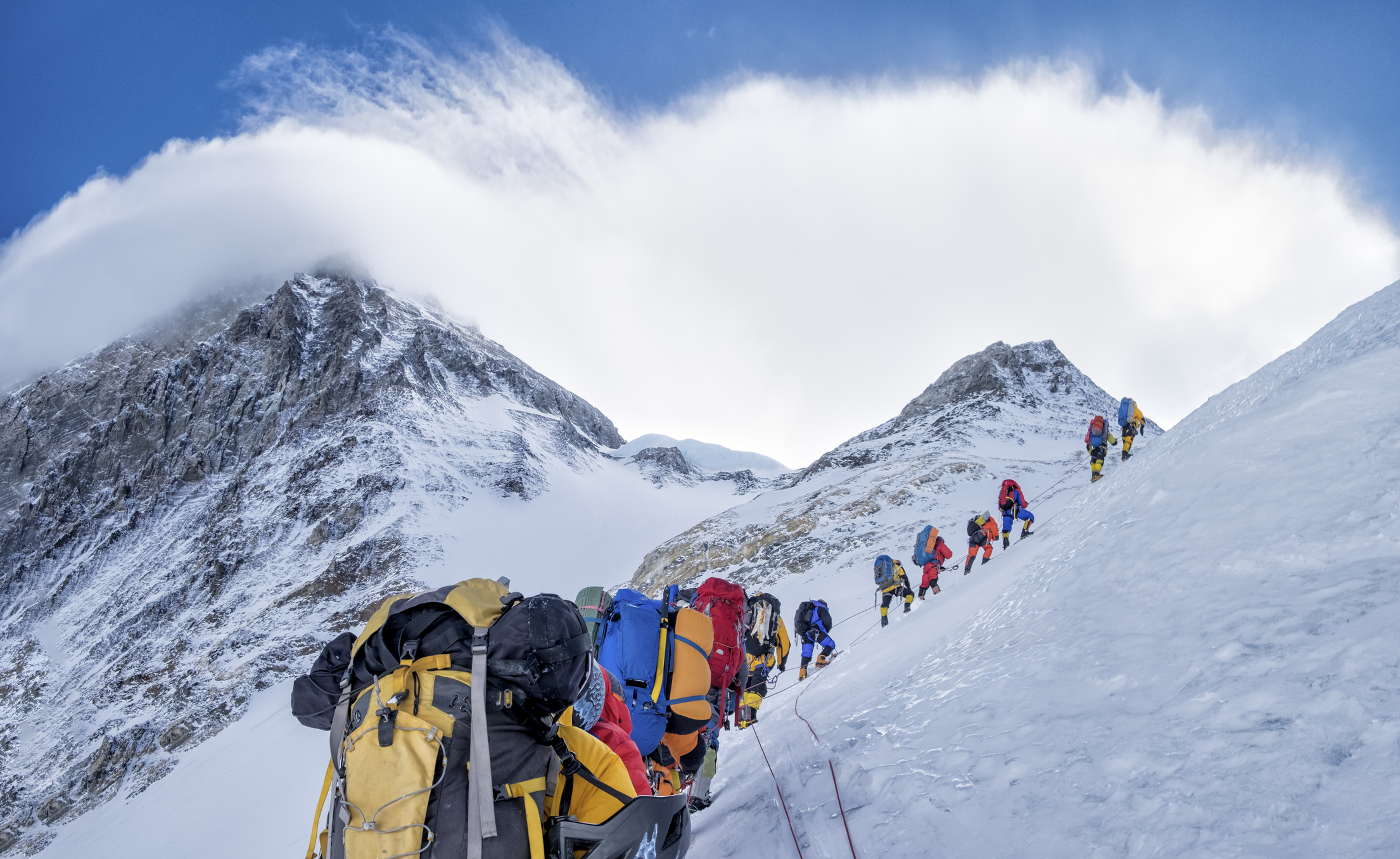What Brings High-Net-Worth People to Everest?
People are paying upwards of $100,000 to climb Mount Everest. Author Will Cockrell argues that's not such a bad thing.


The first documented person to climb the "Seven Summits" — the tallest mountain on each continent — was Dick Bass. He wasn't a professional athlete or mountaineer of any kind, just an American businessman with a dream.
Throughout most of his attempts at the summits, Bass was accompanied by another American businessman with a dream, Frank Wells. Wells missed out only on summiting the tallest mountain in the world, Mount Everest, despite his best efforts. Shortly after abandoning Everest, Wells summited another type of mountain: he was appointed president of The Walt Disney Company (DIS), a role he served for a decade before his death in a helicopter crash.
Bass' ascent of Everest in 1985, and the accompanying media attention he got, kick-started the business of mountain guiding, writes Will Cockrell in Everest, Inc., a new book published this spring. Since then, the guiding industry on Everest has evolved in several ways, but one facet has remained consistent: many of the clients are high-net-worth individuals.
From just $107.88 $24.99 for Kiplinger Personal Finance
Become a smarter, better informed investor. Subscribe from just $107.88 $24.99, plus get up to 4 Special Issues

Sign up for Kiplinger’s Free Newsletters
Profit and prosper with the best of expert advice on investing, taxes, retirement, personal finance and more - straight to your e-mail.
Profit and prosper with the best of expert advice - straight to your e-mail.
"The first wave of people who signed up for guided ascents of Everest included a remarkably high number of dentists and doctors, followed closely by lawyers and investment bankers," Cockrell writes.
Indeed, the image of a high-net-worth businessperson showing up at base camp on the world's tallest mountain with minimal training has haunted Everest lately, with many from outside the outdoors world turning up their noses at perceived entitlement, and many from inside the outdoors world raising alarms about the level of risk introduced by these types of clients.
Cockrell presents a different narrative. Since the days of Dick Bass, the guiding industry has made summitting Everest attainable for people of all kinds of physical fitness by figuring out the proper workflows and infrastructure needed to climb it, to put it in work terms. That alone, Cockrell suggests in his book and in conversation with Kiplinger, is something to be celebrated — and he speaks positively about most clients who decide to try to summit it.
Those who have the means to summit Everest
From the beginning of the industry, high-net-worth individuals were present on Everest attempts simply because they were the people who could afford it.
"Everest has always been an expensive thing to do even for experienced climbers," Cockrell tells Kiplinger, because it requires extensive logistics and work on the ground.
These days, a client climber could expect to pay upwards of $100,000 to join a guided group, and that doesn't take into account, for example, the $10,000+ to spend on necessary gear. Additionally, training before you get to Nepal takes about two hours a day, maybe more, Cockrell says, and, of course, the full trip lasts several weeks, introducing the cost of time.
"High-net-worth people have achieved something in business or gotten to a place where they now have disposable income and free time," Cockrell says. Therefore, they're more able to do something like join an Everest trip.
The Everest mindset and high-net-worth people

But not everyone with a spare two months and $200k decides to try Everest.
After the industry figured out how to reliably guide on the mountain, Cockrell says, "it maybe ceased to represent a climbing challenge and all the sudden became a human challenge."
Rather than seeing Everest as a technical, physical challenge, people can now see it as a challenge of mindset and tenacity. Cockrell likens it to businesspeople who skydive or train for triathlons in their spare time; people who have a "self-belief that they can top themselves" and a drive to seek out new goals are more likely to want to try summiting Mount Everest.
Overall, Cockrell says, what he found in his research for Everest, Inc. is that most clients are really just seeking a transformative experience. Sure, there is "a little slice of the pie" of clients there for narcissistic reasons, but "that's the exception, not the rule," he says. Most climbers are not looking for a picture to post on LinkedIn or something to talk about in their next keynote speech.
"It’s such a common human condition to be in a rut or feel like you want to shake things up or just need a new perspective," he explains. Everest can be that outlet for people, whether you're a stay-at-home parent who hasn't been active in a while, a workaholic who just sold your company, or someone going through a divorce.
Ultimately, even with the advances to make summiting attainable, climbing Everest will push a person to physical and mental extremes and "a little closer to death than you are in your normal life," Cockrell says, so it can be a transformative experience.
The current state of the Everest industry
Over the last three decades, the guiding industry on Everest has grown and evolved as it changed the economy around it as well.
Everest, Inc. documents the expanding numbers of people who now come to the Khumbu region, whether to attempt the peak or just do the trek to base camp. It has had a major impact on the economy of Nepal (where most climbers make their attempts, although you can also climb from the northern, Chinese-controlled side).
As more money was pumped into the mountain, it reached many of the local Sherpa people who found work on and around Everest. What that has meant is that there are now generations who were able to afford more advanced educations, and many of them returned home to set up their own businesses, rather than work for someone else's. As a result, the Everest guiding industry is now dominated by Nepali-owned companies, Cockrell writes.
This, he says, has been the latest big business evolution on Everest. But there are also other, small "disruptors" — for instance, some companies have begun using hypoxic tents so clients can, theoretically, acclimatize at home and thus make their climbing trips shorter, since you don't have to spend as much time acclimatizing in the mountains.
But the biggest overall innovation, Cockrell points out, is that we've managed to tame a mountain that was seen as impossible less than a century ago.
"Everest has taught us it is possible to take just about any experience down to earth," Cockrell says, equating it to how we might one day think about going to space.
Things that were once impossible for regular people are now possible, at least with some grit, training, and a bit of money and time.
Related Content
Profit and prosper with the best of Kiplinger's advice on investing, taxes, retirement, personal finance and much more. Delivered daily. Enter your email in the box and click Sign Me Up.

Alexandra Svokos is the digital managing editor of Kiplinger. She holds an MBA from NYU Stern in finance and management and a BA in economics and creative writing from Columbia University. Alexandra has over a decade of experience in journalism and previously served as the senior editor of digital for ABC News, where she directed daily news coverage across topics through major events of the early 2020s for the network's website, including stock market trends, the remote and return-to-work revolutions, and the national economy. Before that, she pioneered politics and election coverage for Elite Daily and went on to serve as the senior news editor for that group.
Alexandra was recognized with an "Up & Comer" award at the 2018 Folio: Top Women in Media awards, and she was asked twice by the Nieman Journalism Lab to contribute to their annual journalism predictions feature. She has also been asked to speak on panels and give presentations on the future of media and on business and media, including by the Center for Communication and Twipe.
-
 Nasdaq Sinks 418 Points as Tech Chills: Stock Market Today
Nasdaq Sinks 418 Points as Tech Chills: Stock Market TodayInvestors, traders and speculators are growing cooler to the AI revolution as winter approaches.
-
 23 Last-Minute Gifts That Still Arrive Before Christmas
23 Last-Minute Gifts That Still Arrive Before ChristmasScrambling to cross those last few names off your list? Here are 23 last-minute gifts that you can still get in time for Christmas.
-
 The Rule of Compounding: Why Time Is an Investor's Best Friend
The Rule of Compounding: Why Time Is an Investor's Best FriendDescribed as both a "miracle" and a "wonder," compound interest is simply a function of time.
-
 23 Last-Minute Gifts That Still Arrive Before Christmas
23 Last-Minute Gifts That Still Arrive Before ChristmasScrambling to cross those last few names off your list? Here are 23 last-minute gifts that you can still get in time for Christmas.
-
 4 Great Tools to DIY Your Own Financial Plan
4 Great Tools to DIY Your Own Financial PlanSmart Savings Several tools picked out by Kiplinger that DIYers can use to make their own financial plan.
-
 The 7-Month Deadline That Determines Your Lifetime Medicare Premiums
The 7-Month Deadline That Determines Your Lifetime Medicare PremiumsUnderstanding Medicare enrollment is crucial, as missing deadlines can lead to permanent late enrollment penalties and gaps in coverage.
-
 If You're a U.S. Retiree Living in Portugal, Your Tax Plan Needs a Post-NHR Strategy ASAP
If You're a U.S. Retiree Living in Portugal, Your Tax Plan Needs a Post-NHR Strategy ASAPWhen your 10-year Non-Habitual Resident tax break ends, you could see your tax rate soar. Take steps to plan for this change well before the NHR window closes.
-
 Could Target-Date Funds With Built-In Income Guarantees Be the Next Evolution in Retirement Planning?
Could Target-Date Funds With Built-In Income Guarantees Be the Next Evolution in Retirement Planning?With target-date funds falling short on income certainty, retirement plans should integrate guaranteed income solutions. Here is what participants can do.
-
 Should You Renew Your CD?
Should You Renew Your CD?With rate cuts impacting earnings, we examine if now is a wise time to renew CDs.
-
 7 Ways to Plan Now to Save on Medicare IRMAA Surcharges Later
7 Ways to Plan Now to Save on Medicare IRMAA Surcharges LaterUnderstand the critical two-year lookback period and why aggressive planning before you enroll in Medicare is the most effective way to minimize IRMAA.
-
 Where to Store Your Cash in 2026
Where to Store Your Cash in 2026Set yourself up for success with these strategies.